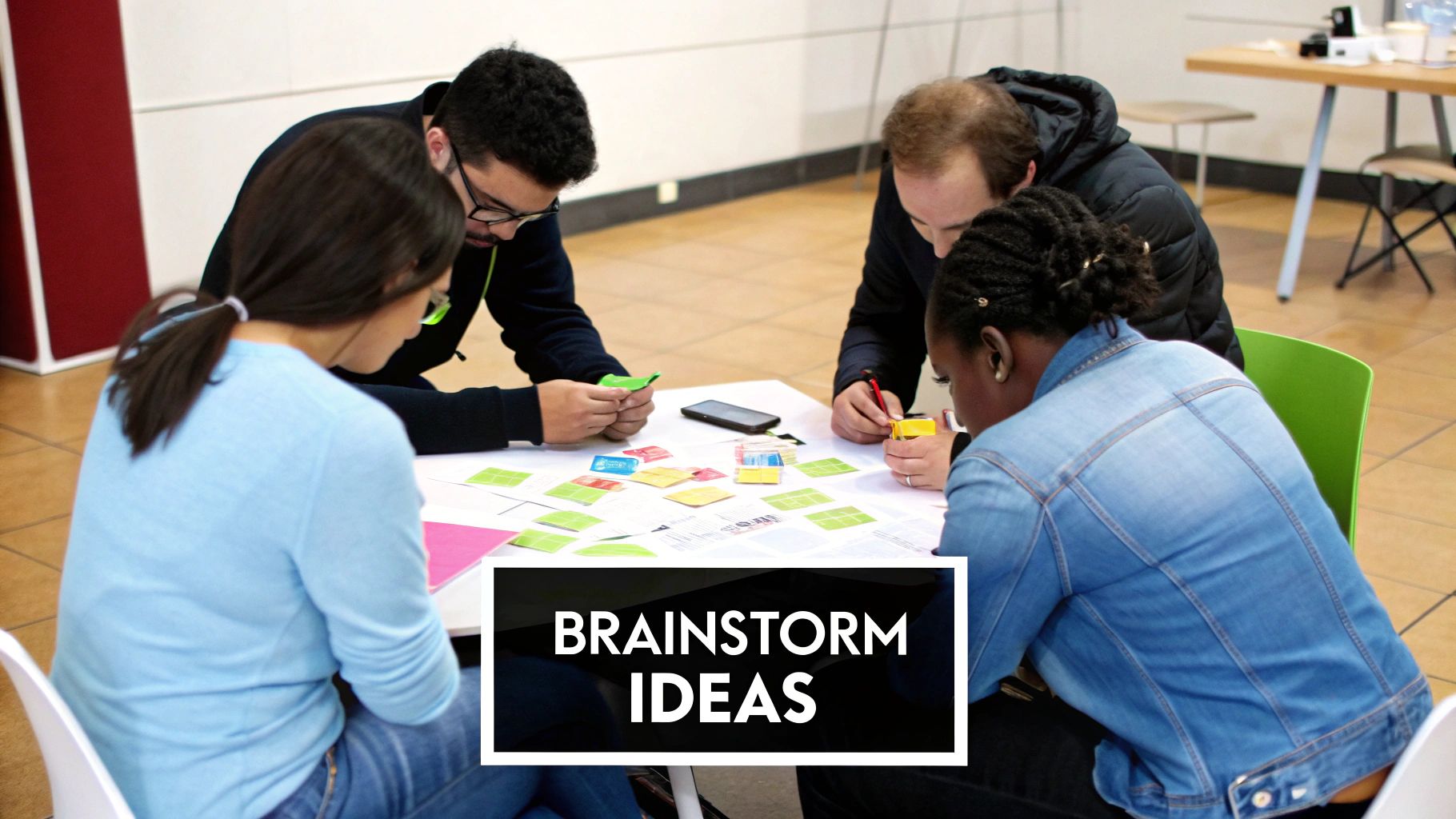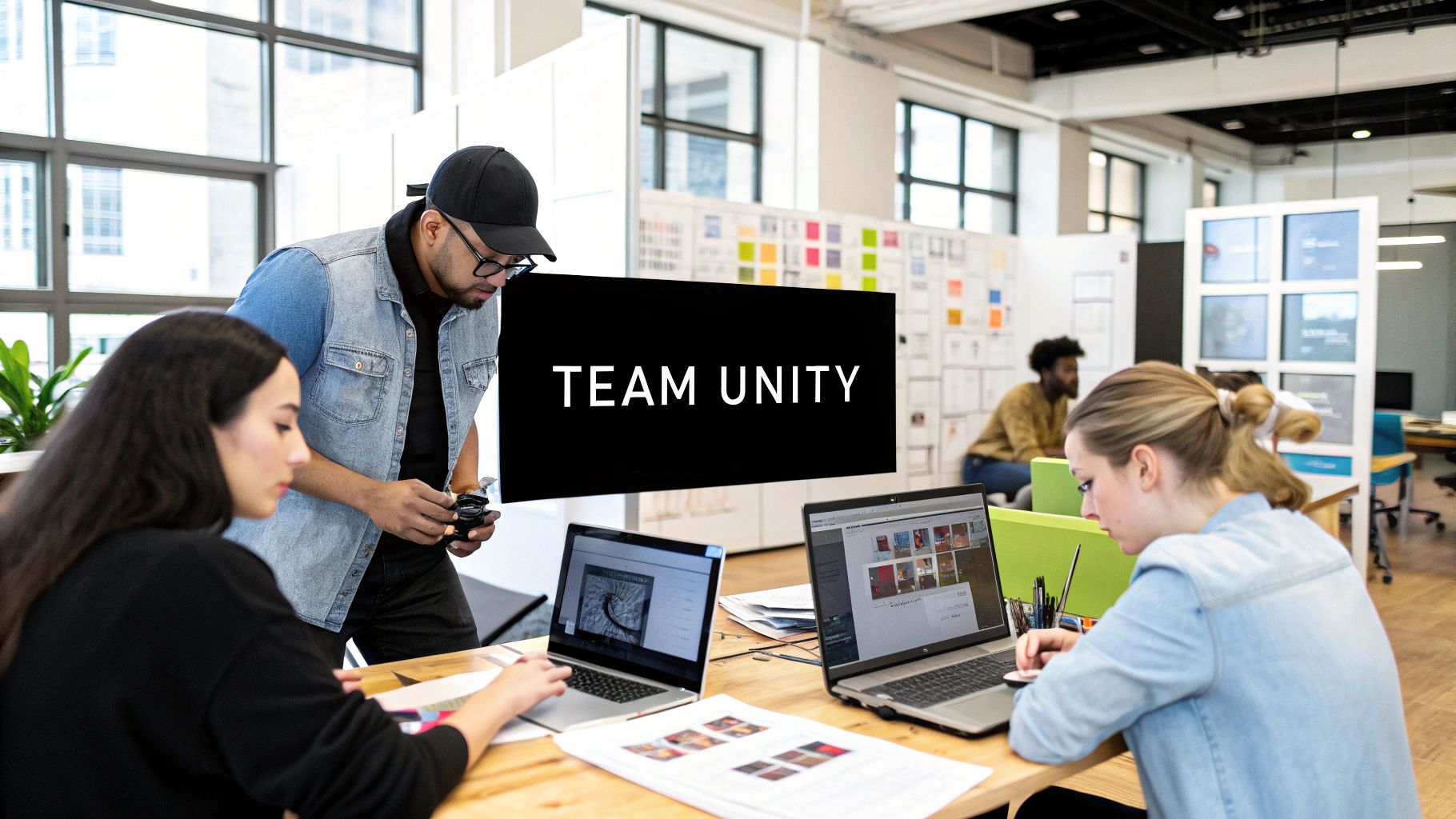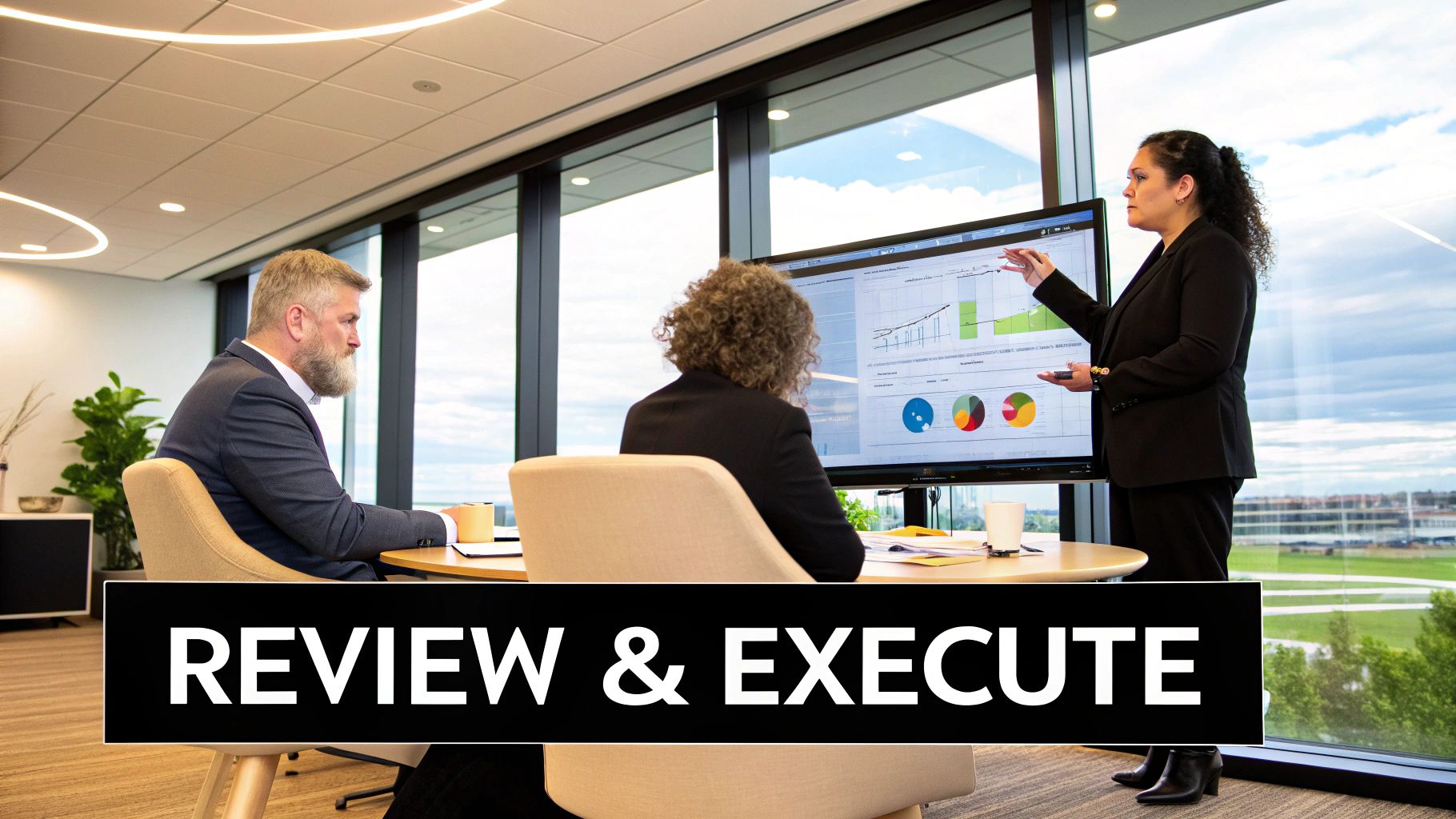The Creative Project Management Revolution

The creative world requires a fresh perspective on project management. Traditional, linear project management methods often clash with the dynamic and iterative nature of creative work. Applying these standard frameworks can stifle innovation and lead to frustration for everyone involved. Successful creative project management hinges on finding the right balance between structure and freedom.
Balancing Structure and Freedom
Imagine composing a piece of jazz music. There's a fundamental structure – a melody and a rhythm – but the true magic comes from improvisation and individual expression within those boundaries. Creative projects thrive in a similar environment. They need a framework that provides direction without restricting the creative process.
This framework should outline clear goals, timelines, and roles, while still allowing room for exploration and experimentation. For example, setting a deadline for a first draft provides structure, but allowing for flexibility during the drafting process itself encourages creative flow.
This balance empowers creatives to take risks and fosters a sense of ownership, ultimately leading to more innovative and impactful results. Clients benefit as well. They gain the reassurance of structure and timelines while still receiving the unique, out-of-the-box thinking they sought from creative professionals. Clear objectives and transparent communication build trust and ensure everyone is aligned.
The Rise of Specialized Approaches
As the demand for creative work increases, so does the need for specialized project management tools and techniques. The growing complexity of creative projects, often involving diverse teams and multiple stakeholders, requires tailored solutions. The creative project management software market is expected to reach $15.06 billion by 2032, with a CAGR of 18.48% between 2024 and 2032. This growth reflects the increasing importance of efficient project management tools for better collaboration, productivity, and overall project success. More detailed statistics can be found at Cognitive Market Research. Organizations are shifting away from generic methodologies and embracing approaches that prioritize both deadlines and creative excellence.
Redefining Success in Creative Projects
This shift also requires a change in how we define success for creative projects. Meeting deadlines and staying within budget are still important, but creative success encompasses more than these traditional metrics. It involves the quality and impact of the work itself: its originality, effectiveness in achieving objectives, and resonance with the target audience. Successful creative project management means implementing systems that not only manage resources and timelines, but also cultivate the creative process and foster an environment where creative excellence can thrive.
Crafting Your Creative Project Framework
Building a successful creative project requires a solid framework. Think of it as the architectural plan for your creative masterpiece. This structure provides the necessary guidance while still allowing room for that all-important creative spark. Finding this balance is crucial for delivering truly exceptional results.
Defining Project Scope
The project scope acts as the guiding star for your project. It ensures everyone is on the same page and moving towards a common goal. However, for creative projects, this scope needs a bit of flexibility to accommodate the evolving nature of creative work.
This means avoiding overly rigid parameters that can stifle the creative process. Instead, concentrate on defining the core objectives and key deliverables. Allow for adjustments as the project progresses and the creative vision takes shape. For instance, rather than meticulously dictating the visual style of a website, focus on the core message it needs to communicate and the target audience it should resonate with.
Establishing Realistic Timelines
Just like a skilled conductor understands the rhythm of a musical piece, a creative project manager needs to respect the tempo of creative work. This means recognizing that creativity often happens in stages. There will be periods of intense brainstorming, quiet reflection, and collaborative feedback.
Creating realistic timelines that account for these different phases is essential. Building in buffer time for revisions and unforeseen delays helps alleviate pressure and fosters a more sustainable creative workflow.
Assigning Roles and Responsibilities
Clearly defined roles and responsibilities empower team members to take ownership of their contributions. In creative projects, however, it's important to avoid rigid structures that stifle innovation. The key is to focus on individual strengths and encourage collaboration.
Think of a jazz ensemble, where each musician contributes their unique talent to create a harmonious whole. Similarly, assigning roles based on expertise while promoting open communication and cross-functional collaboration can maximize the creative potential of the team. Poor project management can lead to wasted resources – approximately 12% according to some studies. The increasing need for skilled project managers is clear, with an estimated 25 million new professionals required by 2030. For more detailed statistics, check out: ProofHub Project Management Statistics.
Building a Flexible Foundation
A flexible foundation for your creative project is like building a house with adaptable rooms. It provides a solid structure while allowing for modifications as needed. This adaptability is key for navigating unexpected changes or integrating new ideas that often arise during the creative process.
This approach allows the project to grow organically, increasing the likelihood of achieving breakthrough results. Clients also benefit from this flexible approach. It ensures their needs are met while providing space for creative exploration, potentially leading to even better outcomes than originally envisioned.
To better illustrate the differences between traditional and creative project management, let's look at a comparison table:
Creative Project Framework Components
A comparison of essential elements needed in creative project frameworks versus traditional project management
| Framework Component | Traditional Approach | Creative-Focused Approach | Key Benefit |
|---|---|---|---|
| Scope | Fixed, detailed specifications | Core objectives, flexible deliverables | Adaptability to evolving creative vision |
| Timeline | Strict deadlines, minimal buffer | Realistic timelines, buffer time for iterations | Reduced pressure, sustainable workflow |
| Roles & Responsibilities | Rigidly defined roles | Collaborative, leveraging individual strengths | Maximized creative potential |
| Foundation | Unchanging, pre-determined | Adaptable, accommodating change | Breakthrough results, client satisfaction |
This table highlights how a creative-focused approach prioritizes flexibility and collaboration while still maintaining a structured foundation. This balance is essential for fostering innovation and delivering truly exceptional results in creative projects.
Choosing Tools That Empower Rather Than Restrict

The tools your creative team uses can heavily influence their success. Think of it like an artist and their brushes: the right tools are essential for bringing any vision to life. Choosing systems that empower, not hinder, creativity is key. This means looking beyond just the features and considering how well they fit your team’s specific workflow and creative environment.
Avoiding the "More Is Better" Trap
It's easy to think that the priciest platform with the most bells and whistles is the best choice. However, this isn't always true. Too many features can actually stifle creativity, becoming overwhelming and distracting. For instance, a small design team working on quick projects might find a complex project management system with in-depth reporting to be overkill. A simpler, more intuitive system would likely be a much better fit.
This highlights the importance of assessing tools based on your team’s unique needs.
Tailoring Tools to Your Team
The best tools complement your team’s current workflow, seamlessly integrating with their preferred communication and collaboration styles. This means understanding your team’s creative process and selecting tools that support it. Don't force them to adapt to a new, potentially clunky system.
Talk to your team to understand their current pain points and preferences. This can help you pinpoint the features they actually need and avoid paying for unnecessary ones. Also, consider your team’s creative culture. A visually driven team might benefit from a platform with strong mood board and file-sharing capabilities. A recent survey found that 78% of teams revamping their creative project management used incoming request data as a major factor in their decisions, emphasizing the importance of data-driven insights. You can find more detailed statistics here. Furthermore, those using dedicated project management software are 426% more likely to succeed.
All-in-One vs. Specialized Tools
The debate between all-in-one solutions and specialized tools is ongoing in creative project management. All-in-one platforms conveniently centralize project information and communication. However, they might lack the specific functionalities needed for certain creative tasks. Specialized tools excel in particular areas, like Adobe Photoshop for graphic design or Adobe Premiere Pro for video editing, but can create data silos and communication issues when used alone. The best approach often involves a mix of both, integrating specialized tools with a central project management platform to streamline communication and maintain a clear overview.
Implementing New Tools Effectively
Rolling out new tools should be a collaborative effort, not a top-down decree. Involve your team early in the selection process, getting their feedback and addressing any concerns. This not only increases the chances of successful adoption but also builds a sense of ownership.
Start with a pilot program, letting a small group test the tools and provide feedback before a wider rollout. This lets you identify potential problems and make adjustments early, minimizing disruption and maximizing the benefits of your new tools. Just as a conductor guides an orchestra, the right tools orchestrate the creative process, leading to harmonious and impactful results.
Building Creative Team Synergy That Actually Works
Great creative work rarely happens in isolation. However, throwing people together doesn't guarantee innovative results. Forcing collaboration can even stifle creativity, leading to compromises instead of breakthroughs. The key to successful creative projects lies in fostering genuine synergy. This involves structuring interactions, facilitating constructive feedback, and cultivating a risk-taking environment.
Structuring Brainstorming Sessions for Success
Brainstorming sessions are essential for creative projects. But without structure, they can become unproductive. Successful creative directors understand the importance of setting clear objectives. This means defining the problem and the desired outcome of the session.
Establishing ground rules also encourages participation. A "no bad ideas" rule can create a safe space for unconventional suggestions. This encourages diverse thinking and allows unexpected creativity to emerge. It's like a jazz improvisation: there's structure, but the magic happens with individual contributions.
Facilitating Feedback That Elevates, Not Deflates
Feedback refines creative work, but it can be detrimental if delivered poorly. The key is constructive criticism. This means framing feedback as suggestions, not personal attacks.
Focusing on the work, not the individual, maintains a positive environment. Instead of saying "Your design is too cluttered," try "I wonder if simplifying the layout would enhance the message." This subtle shift in language can make a big difference.
Creating a Safe Space for Creative Risks
Innovation comes from venturing beyond the comfort zone. Effective creative project management fosters a culture of risk-taking. This requires trust and mutual respect within the team.
This can involve encouraging experimentation and viewing failures as learning opportunities. Like a scientific experiment, not every hypothesis leads to a breakthrough, but each attempt contributes to understanding. When team members feel safe pushing boundaries, they generate original ideas.
Resolving Creative Differences Constructively
Disagreements are inevitable in creative projects where subjective interpretations matter. However, conflict can be managed effectively. Successful project management equips team members with skills to navigate differences constructively.
This might involve active listening, where individuals understand each other’s perspectives. Finding common ground and shared goals can transform conflicts into opportunities for stronger work. It's like weaving different threads together to create a richer tapestry.
To further understand effective collaboration, let's examine a comparison of various methods:
The following table explores the strengths and weaknesses of different creative collaboration methods:
"Creative Collaboration Methods Comparison"
"Effectiveness of different collaboration approaches for various creative project types"
| Collaboration Method | Best For | Challenges | Implementation Tips |
|---|---|---|---|
| Brainstorming | Generating diverse ideas | Can become unfocused | Set clear objectives, establish ground rules |
| Critique sessions | Refining existing work | Can be demoralizing if not handled carefully | Focus on constructive feedback, create a safe space |
| Pair design | Collaborative problem-solving | Requires strong communication | Establish clear roles and responsibilities |
| Agile sprints | Iterative development | Requires disciplined time management | Define clear deliverables for each sprint |
This table highlights the importance of choosing the right method for your specific project and implementing it effectively. By understanding the strengths and weaknesses of each approach, you can maximize the potential for successful creative collaboration.
Managing Client Relationships Without Compromising Vision

The client-creative relationship can be tricky. It has the power to inspire amazing work, but it can also be a source of frustration. This section explores how to navigate this dynamic, ensuring client satisfaction while staying true to your creative vision. Finding this balance is key to producing work that meets objectives without sacrificing artistic integrity.
Setting Clear Expectations Upfront
Successful creative projects begin with clear communication. This means establishing expectations from the start, so both you and the client are on the same page. For example, clearly state the number of revisions included in the project. This prevents scope creep and keeps the project moving forward.
Also, establish a clear feedback process. This ensures client input is effectively managed and incorporated. This initial clarity helps avoid misunderstandings and builds a solid foundation for a collaborative partnership. Think of it as a project roadmap, guiding everyone in the same direction.
Presenting Work Strategically
The way you present your work greatly influences how it’s received. Structure your presentations to emphasize the strategic thinking behind your creative choices. Explain how your work aligns with the client’s goals, focusing on the “why” behind your decisions.
Don't just show the final product; walk them through your process. For example, when presenting a logo design, explain the symbolism and how it relates to the brand identity. This approach engages the client, making them an active participant in the creative process. It also positions you as a strategic partner, not just a vendor.
Handling Revision Requests Diplomatically
Revision requests are a part of creative work, but they can be managed effectively. The key is to approach them with diplomacy. Try to understand the client's concerns before making any changes.
Ask clarifying questions to understand the reasoning behind their feedback. This transforms potential conflict into a collaborative discussion. This approach helps maintain a positive client relationship while ensuring revisions are strategic and beneficial to the project. By understanding the client’s perspective, you might even find alternative solutions that address their needs while preserving your creative vision.
Educating Clients About Creative Workflows
Many clients are unfamiliar with the nuances of creative work. Educating them about your process can turn them from critics into collaborators. Explain the rationale behind each stage, highlighting the importance of research, ideation, and refinement.
This transparency builds trust and fosters a more collaborative relationship. It also helps clients give more informed feedback, ultimately leading to stronger results. Just like a conductor leads an orchestra, managing client relationships effectively orchestrates a harmonious and successful project for everyone involved. This creates a more positive and productive experience for all.
Measuring Creative Success Beyond Gut Feelings
Creative work can often feel intangible. How do you measure something as subjective as creative excellence? While gut feelings certainly have a place, effectively managing creative projects demands more concrete metrics. Forward-thinking creative leaders move beyond subjective opinions and establish meaningful key performance indicators (KPIs) that reflect both creative brilliance and project efficiency.
Establishing Meaningful KPIs
KPIs provide a quantifiable method for tracking progress and measuring success. For creative projects, these KPIs need to extend beyond traditional project management metrics like deadlines and budgets. They must reflect the unique nature of creative work itself.
For example, measuring the number of unique design concepts generated during a brainstorming session can gauge the team's ideation output. Tracking the click-through rate of a social media campaign designed by the team offers insights into its effectiveness. This highlights the importance of carefully selecting KPIs that align with the specific objectives of the creative work.
Visualizing Progress Without Stifling Creativity
Visual progress trackers can be powerful tools for managing creative projects. However, it's crucial that these trackers don't become rigid constraints that stifle the creative process. Instead, they should serve as a transparent way to communicate progress and identify potential roadblocks.
Tools like Kanban boards can visually represent the workflow, displaying the status of each task and the overall project progression. This provides clarity without imposing excessive rigidity, similar to a conductor using a score to guide an orchestra while still allowing for individual expression within the musical framework.
Implementing Continuous Feedback Systems
Feedback is essential for creative projects. Implementing a system for continuous feedback, both internal and external, is crucial for improvement. This system needs structure to ensure feedback is constructive and actionable.
Regular critique sessions with clear guidelines for feedback delivery can elevate the quality of work. Feedback should focus on specific aspects, offering concrete suggestions for improvement instead of vague criticisms. Anonymous feedback mechanisms can also encourage honest input and foster open communication.
Demonstrating the Tangible Impact of Creative Work
One of the biggest challenges in managing creative projects is demonstrating the tangible impact of the work to stakeholders. This requires connecting creative outputs to measurable business outcomes.
For example, showing how a new branding campaign led to increased brand awareness or how a redesigned website boosted conversions demonstrates the value of the creative team's efforts. This involves tracking relevant metrics and presenting them clearly and concisely to stakeholders. By highlighting the tangible benefits of creative work, you can justify investments and secure continued support for future projects. This transforms the perception of creative work from a cost center to a valuable asset that drives business growth.
Conquering Creative Project Roadblocks

Every creative project faces obstacles. Knowing how to handle these challenges is key to success. This section explores common roadblocks and offers practical solutions from experienced creative leaders. We'll look at identifying warning signs, preventative measures, and developing contingency plans.
Scope Creep: The Ever-Expanding Project
Scope creep is the gradual expansion of a project beyond its original goals. It often leads to budget overruns, missed deadlines, and team burnout. One effective solution is establishing clear boundaries from the start.
Document the project scope thoroughly and get client approval. Also, implement a formal change request process. This allows for controlled scope adjustments while keeping everyone informed of the impact. Think of it like pruning a plant – keeping the project focused and healthy.
Resource Limitations: Doing More With Less
Limited resources, whether budget, personnel, or time, can significantly impact creative projects. However, these constraints can also breed innovation. Prioritize tasks based on impact and feasibility to ensure the most important elements get the attention they deserve.
Another helpful tactic is exploring alternative resources. Consider using stock photos from sites like Adobe Stock or working with freelancers on platforms like Upwork to supplement your team. This resourcefulness can help overcome limitations and deliver successful projects.
Creative Blocks: Overcoming the Mental Hurdle
Creative blocks are an inevitable part of the creative process. Those moments when inspiration fades can be frustrating, but several techniques can help. Encourage team members to step away from their work and engage in activities that spark creativity.
This could involve visiting an art gallery, listening to music, or taking a walk in nature. A supportive team environment where individuals feel comfortable sharing their struggles is also crucial. This can help break through mental barriers and reignite that creative spark.
Team Burnout: Preventing Creative Exhaustion
Team burnout, a state of emotional, physical, and mental exhaustion, can derail any project. Prioritize team well-being to prevent burnout. This includes encouraging regular breaks, setting realistic deadlines, and promoting a healthy work-life balance.
Celebrating milestones and acknowledging individual contributions is also essential. This boosts morale and strengthens team cohesion. By prioritizing well-being, you're investing in the long-term success of your projects.
Contingency Planning: Preparing for the Unexpected
Creative projects often involve unpredictable elements. Contingency planning, preparing for potential problems, is crucial. Identify potential risks, such as client changes or technical difficulties, and develop backup plans.
This might involve having alternative design options or identifying replacement resources. Anticipating potential challenges minimizes their impact and keeps the project on track. Just like a captain prepares a ship for storms, contingency planning helps projects weather any unexpected challenges.
Successfully managing creative projects requires more than just creative talent. It demands effective leadership and strategic planning. By understanding and addressing these common roadblocks, you can pave the way for creative success.
Looking for a platform to find and manage creative talent? Creativize connects businesses with local creative professionals, providing the resources you need to bring your vision to life. Explore the possibilities and discover the power of local talent.

